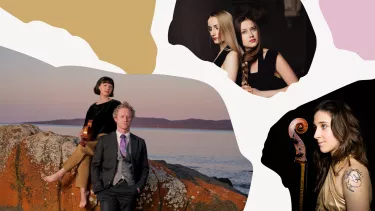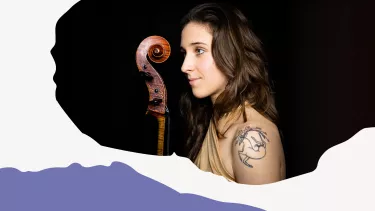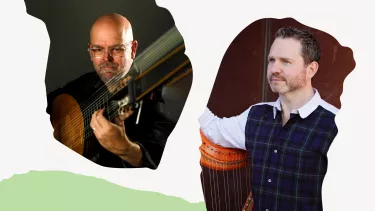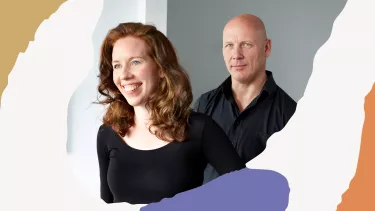Evolving Traditions: Your Guide to Utzon Music 2025
Ahead of the stellar new season of Utzon Music, curator and musician Genevieve Lacey unpacks what you can expect from the series

Like humans, music takes many forms, shaped by different landscapes, languages, ways of living and listening. Through every age, music and musicians have been border-crossers: melodies, instruments, players and chord progressions migrating and morphing in constant search of new forms, new listeners. Beloved traditions become the inspiration for fresh compositions, as reinvention and rebirth give cultures ongoing vitality.
Utzon Music 2025 celebrates human curiosity and discovery. We welcome an exceptional cast of guest musicians, all of whom have made the world their home. Each carries with them an ever-evolving sense of tradition and an openness to the possibilities of new creation and collaboration.
Musicians traverse centuries, countries and cultures daily. Immersed in different repertoire, styles of music, ever-changing groups of colleagues and contexts, they become adept at remaking themselves in countless, chameleon-like ways in their service of sound. Most are steeped in traditions, the ancestry of their instruments cross-pollinating with the sounds and stories of their families and cultures. In our current, wildly mobile world, with astonishing access to live and digital music of so many origins, musicians’ relationships with the histories and customs entwined with their chosen instrument or voice are increasingly layered.

A treasury of instruments
Our 2025 series also welcomes a compendium of exquisite instruments, many known and loved, others potential discoveries.
Alongside decorated players of traditional Western classical instruments: violin (Kristīne Balanas, Emily Sun), viola (Katie Yap), cello (Margarita Balanas, Annie Jacobs-Perkins), double bass (Mats Eilertsen), piano (Aura Go, Morten Qvenild), we also enjoy the articulate company of plucked instruments: guitar (Slava Grigoryan), harp (Marshall McGuire), and the sparkling clarity of the harpsichord (Donald Nicolson).

With its giraffe-like neck, the theorbo lends an elegant physical and sonic presence to any stage it graces. Played here by Simon Martyn-Ellis, in compositions both baroque and newly composed, the theorbo has a range similar to the cello. But the very long string length of the theorbo makes the usual upward tuning progression impossible — those two top strings would be so thin they’d snap. With fourteen courses — the term lutenists and early guitarists use for strings — the theorbo is therefore distinguished by what’s called ‘re-entrant tuning’, which means that the last two of the instrument’s strings are tuned an octave lower. The result is a rich and heart-stirring resonance.
James Crabb is a proud ambassador for his instrument, the classical accordion, and in his hands, it becomes a voice of incredible artistry. Descended from the Chinese sheng (a reed mouth organ), evolving over many centuries in various folk traditions, beloved in the polka craze of the nineteenth century, popular in vaudeville, tango bands and pop music, classical accordion came into its own in the mid-twentieth century, and is now capable of the most complex and eloquent of music.

For Utzon Music 2025, James Crabb’s accordion meets my own collection of handmade recorders in a unique and vivid collaboration. The recorder is an ancient instrument of great beauty and facility, flourishing in Renaissance consorts, immortalised in its golden age by Vivaldi, Handel, Bach and Telemann, resurfacing in the twentieth century, alongside the revival of interest in historical instruments, and now, celebrated for its diversity of sound by contemporary composers and players around the world.
Played on the lap while sitting, the qanun is an instrument of zither-like form, generally with 72-74 strings, able to be tuned in countless ways to allow for the expressive fluency of classical Persian music. For Utzon 2025, this dramatic instrument is played by Vahideh Eisaei. Alongside her, Pegah Kheirdoush plays the upright, bowed kamancheh, with its ornate inlays, elaborate carved pegs, four strings and soulful sound, alongside a range of hand-held, classic Middle Eastern percussion instruments from Iran, played by Sohrab Kolahdooz. Also featured is one of Persia’s most beloved and eloquent instruments, the oud, played by celebrated composer and teacher Hamid Khansari. A fretless lute, the oud has inspired Western equivalent plucked stringed instruments through the ages.

Hardanger fiddle is considered the soul of Norwegian music. Originally a seventeenth-century instrument, a similar size to the violin, it has eight strings, four of which are beautifully named ‘sympathetic strings’, creating extra resonance and possibilities for chordal playing. Played for Utzon by iconic Norwegian player Benedicte Maurseth, this is a rare chance to encounter this haunting instrument.
The human voice, perhaps the most expressive of all instruments, is celebrated across this series in a myriad of ways. From the rich, mellow tones of operatic mezzo-soprano (Catriona Morison) singing classic lieder (Mahler, Brahms) to the consort-like purity of six female acapella voices (Sjaella) singing early music (Purcell, Janequin) and polished arrangements of folk tunes, to the sinuous eloquence of Persian singing (Saba Pashaee), 2025 celebrates many classical styles of singing.

Composing performers
The most compelling interpreters have an uncanny ability to make classic repertoire sound as though it’s being discovered and invented before our ears and eyes. This ability not only to inhabit the notes, but to call upon the many possible resonances of a work in order that many listeners can find a way to connect, is one of the hallmarks of a truly remarkable artist.
Classical music has a long tradition of performers who are also accomplished composers, improvisers, and arrangers. Think of Barbara Strozzi, Johann Sebastian Bach, Clara Schumann, Franz Liszt, Elena Kats-Chernin, Julius Eastman, Ryuichi Sakamoto, Anoushka Shankar, Lou Bennett, to name a few. Following in that tradition, many of our performers in Utzon Music 2025 also arrange and compose, drawing on their classical training and traditions, and their inside knowledge of their instruments. Spending days and nights wrapped in sound gives a particular perspective on music, and many of these musicians create from their practical, physical knowledge of the mechanics of playing, as well as their imagination and intellect, drawing on decades of listening to, and learning from many kinds of music.
Some spheres of notated music allow more room for a player’s own embellishments and contributions than others. Much of the music we hear across this series emerges from traditions where improvising is inextricably linked with performing and composing, and familiar chord patterns or melodies are manipulated, re-composed and re-born in quite radical or deeply personal ways with each performance.

New perspectives
Utzon Music has a lovely tradition of renewing its curator every few years. With each appointment comes a new set of perspectives, artists and repertoire for an audience to discover. In 2025, I’m delighted to join the list of distinguished colleagues who have held this position, as the latest Utzon curator.
As a professional musician myself, my programming gives Utzon Music listeners a fresh take on chamber music experiences, inspired by the constant listening and curiosity about sound that are my life’s passions. My work takes me in and out of concert halls, festivals and recording studios nationally and internationally, providing widely diverse performance and listening contexts across musical genres and cultures. I’ve always been drawn to exploring the ever-expanding field of chamber music, and this series embodies my long-held inquisitiveness about sound, musicians, repertoire, and the magic that happens between players and listeners when music is shared live. Contemporary Australia is a stunning melting pot of cultures, people and traditions, and my vision for Utzon 2025 brings this many-voiced celebration to the fore, in the company of musicians who vividly recreate and remake their cultures through sound.

Utzon’s listening space
Utzon Music Series takes place in Utzon’s own room. This lovingly created space, with chairs, tapestry and architecture designed by Jørn Utzon, gives visitors a rare glimpse into Utzon’s ideal, personal listening experience. In this light drenched room, there’s a sense of peace and welcome. It’s a perfect space for dreaming, which enhances listening. For players, such proximity to their listeners gives a beautiful sense of convivial, intimate sharing of sound. And for audiences, hearing every breath, every finger move on the instruments right before them is spine tingling in its humanity.
Looking beyond the musicians to light dancing on water, listeners can enjoy music old and new being brought to life with them. Music ever living, ever changing, built on ancient traditions, and exuberantly alive.